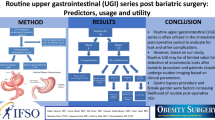Abstract
Background
Routine upper gastrointestinal (UGI) studies following laparoscopic Roux-en-Y gastric bypass (LRYGBP) have the potential advantage of early identification of anastomotic complications. The aim of our study was to evaluate the efficacy of routine postoperative UGI and its relationship to clinical outcomes.
Methods
Over a three-year period, 516 patients underwent LRYGBP followed by routine postoperative UGI studies. Data were collected on the results of the UGI, clinical parameters, and patient outcomes. Study groups were composed of patients with a normal UGI (Group I, n = 455), abnormal UGI not requiring further intervention (Group II, n = 36), and abnormal UGI requiring further intervention (Group III, n =25). Statistical significance was set at α= 0.05 level for all analyses.
Results
The three study groups were not statistically different in mean age (42 years) or body mass index (BMI) (45) and were predominantly female (90%). Most patients had an uneventful postoperative course. Anastomotic complications (gastrojejunostomy and jejunojejunostomy) were uncommon (1.3%). The sensitivity of the UGI for anastomotic leak in this study was low (33%). However, all patients with alimentary limb obstruction (n = 3) had UGI evidence of this complication. Of the 516 UGI reports, there were only 25 (4.8%, Group III) that were abnormal and required some form of intervention ranging from serial imaging (84%) to reoperation (16%). Of the various clinical parameters examined, the patients in Group III demonstrated a significantly higher prevalence of fever (p < 0.001), tachycardia (p < 0.01), vomiting (p < 0.001), and postoperative day 1 leukocytosis (p < 0.005).
Conclusions
Our data suggest that routine UGI after LRYGBP has limited utility as it may result in unnecessary intervention based on false-positive results or a delay in treatment based on false-negative results. We advocate selective UGI imaging following LRYGBP based on the patient’s clinical factors, particularly fever and tachycardia.
Similar content being viewed by others
References
Albrecht RJ, Pories WJ (1999) Surgical intervention for the severely obese. Baillieres Best Pract Res Clin Endocrinol Metab 13:149–172
Freys SM, Tigges H (2001) Quality of life following laparoscopic gastric banding in patients with morbid obesity. J Gastrointest Surg 5:401–407
Schauer PR, Ikramuddin S (2001) Laparoscopic surgery for morbid obesity. Surg Clin North Am 81:1145–1179
Pope GD, Birkmeyer JD (2002) National trends in utilization and in hospital outcomes of bariatric surgery. J Gastrointest Surg 6:855–861
Serafini F, Anderson W (2002) The utility of contrast studies and drains in the management of patients after Roux-en-Y gastric bypass. Obes Surg 12:34–38
Sims TL, Mullican MA (2003) Routine upper gastrointestinal gastrografin swallow after laparoscopic Roux-en-Y gastric bypass. Obes Surg 13:66–72
Lyass S, Khalili T (2004) Radiological studies after laparoscopic Roux-en-Y gastric bypass: routine or selective? Am Surg 70:918–921
Singh R, Fisher BL (2003) Sensitivity and specificity of postoperative upper GI series following gastric bypass. Obes Surg 1:73–75
Katsani V, Leeth R (2005) Water soluble upper GI based on clinical findings is reliable to detect anastomotic leaks after laparoscopic gastric bypass. Am Surg 71:916–919
Hamilton EC, Sims TL (2003) Clinical predictors of leak after laparoscopic Roux-en-Y gastric bypass for morbid obesity. Surg Endosc 17:679–684
Acknowledgments
The authors thank Mr. William Smith for his assistance in accumulating data and Mrs. Marie Carvidi for her editorial assistance. This research was supported by a research grant from Stryker Endoscopy.
Author information
Authors and Affiliations
Corresponding author
Additional information
Poster presentation at the annual meeting of the Society of American Gastrointestinal Endoscopic Surgeons (SAGES), Las Vegas, Nevada, April 2007
Rights and permissions
About this article
Cite this article
Doraiswamy, A., Rasmussen, J.J., Pierce, J. et al. The utility of routine postoperative upper GI series following laparoscopic gastric bypass. Surg Endosc 21, 2159–2162 (2007). https://doi.org/10.1007/s00464-007-9314-9
Received:
Revised:
Accepted:
Published:
Issue Date:
DOI: https://doi.org/10.1007/s00464-007-9314-9




